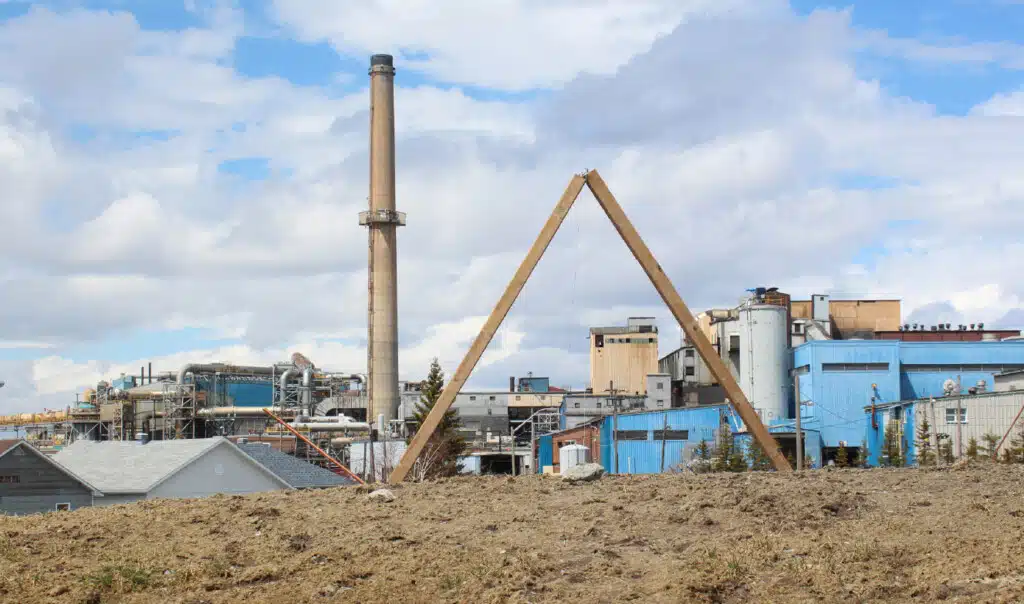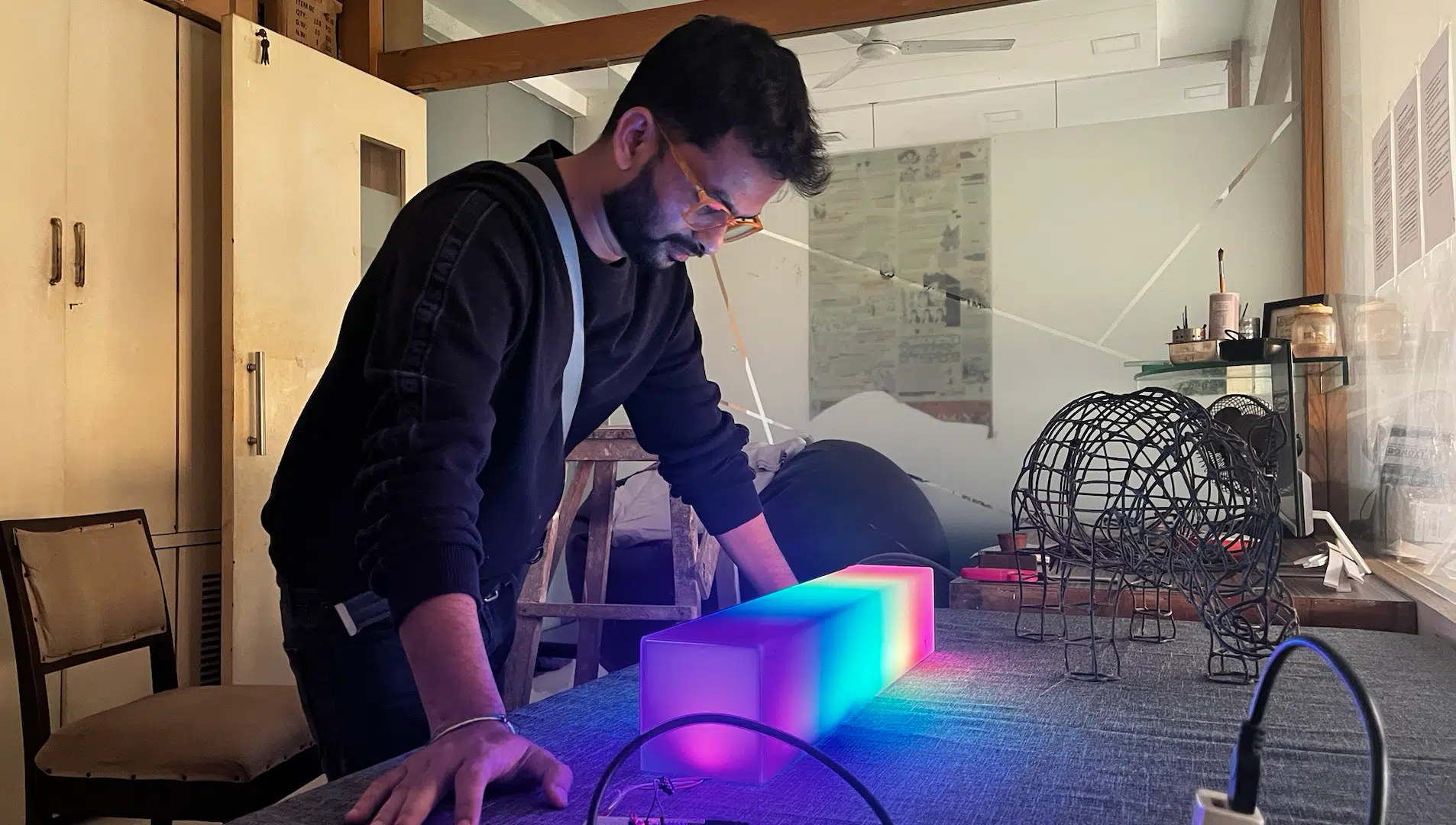Sashikanth Thavudoz tells stories of communities and their relationship to the land through industrial and organic materials, presented in their purest forms. Based in Baroda, Gujarat, where he has lived for 17 years since arriving in the city for graduation in Fine Art at the Maharaja Sayajirao University, the artist has become best known for his precise interventions in landscapes, calling attention to the cultural and natural histories of his sites and their resources. The works, be it neon tube lights installed in a sub-arctic iron mining town in Quebec, Canada, or a foil-wrapped marble boulder in a quarry in Rajasthan, derive from and become part of their surroundings, unassuming despite their scale. A shift of the light can make Thavudoz’s work appear or disappear.
The work often begins at the artist’s home studio on the ground floor of an apartment building, where he draws, builds models and experiments with found materials. “My studio is a dynamic space that shifts with each project,” says the artist. “It’s constantly in flux… ‘play’ is integral to my practice. The studio is a hub of thought experiments.” These experiments spill out from the studio to his backyard, various city industrial manufacturing workshops, and most importantly, to his installation sites.
“I draw inspiration from my surroundings, places, people, and materials. The idea is not to impose my story onto a material but to let each element unveil its own narrative.”
“I spend a lot of time talking to people wherever I am working,” says the artist, “and the conversations become the basis of my work.” For a residency project in Rouyn-Noranda, a smelting town in Quebec, Canada, for example, the artist spent most of his time in conversation — with indigenous peoples, local artists, activists and government officials — and gathered their various and often opposing perspectives on the effects of smelting into an installation of precariously constructed geometric sculptures made using copper pipes and wooden blocks, to convey the feeling of a teetering balance. Similarly, the notion of covering marble in metal foil for an installation in a marble quarry in Talvada, Rajasthan, came from conversations with local inhabitants who would use discarded pieces of marble from the quarry to create memorials for the dead or deities by wrapping the pieces in a metallic foil. “After I covered a boulder in foil, everyone started respecting it,” Thavudoz says.
The artist creates his interventions by using simple local materials such as wood, copper, marble, and foil. “I draw inspiration from my surroundings’ places, people, and materials. The idea is not to impose my story onto a material but to let each material unveil its own narrative.” Inspired by movements such as Arte Povera, Process Art and Minimalism, raw and pure materiality is at the heart of all that Thavudoz creates. “I am interested in how I can express ideas with the simplest elements,” he continues. “During my academic days, I was obsessed with the line. I was obsessed with Nasreen’s works [referring to Nasreen Mohamedi, an artist who pioneered minimalism in India]. I wanted to see how I could use just the line to create depth, dimension, emotion.” For Thavudoz, the simplest materials handled delicately can radically transform themselves and the viewer.

 Top: Sashikanth Thavudoz, ‘Sandarbh-Référence’, 2018, site-specific installation in Rouyn-Noranda, Canada; Bottom: The artist on site in Talvada, Rajasthan creating the site-specific installation ‘Sandarbh’ (2012). Images courtesy of the artist.
Top: Sashikanth Thavudoz, ‘Sandarbh-Référence’, 2018, site-specific installation in Rouyn-Noranda, Canada; Bottom: The artist on site in Talvada, Rajasthan creating the site-specific installation ‘Sandarbh’ (2012). Images courtesy of the artist.
Thavudoz is the winner of the third edition of ‘The Future is Born of Art’ Commission, led by BMW India and India Art Fair, following Faiza Hasan and Devika Sundar, the winners of the 2022 and 2023 Commissions, respectively. In its third year, the Commission has been expanded to award a young Indian artist a generous prize of INR 10,00,000, one of the largest in the country, including a direct cash prize and support for travel and accommodation in order to create an immersive and large-scale installation at the India Art Fair on the theme of ‘Forwardism’, with the all-electric BMW i7 at its centre. Selected with the help of an advisory panel made up of distinguished patron and conservationist HRH Radhikaraje Gaekwad, India Art Fair Fair Director Jaya Asokan, curator Veeranganakumari Solanki and artist Sameer Kulavoor, the aim and ambition of the Commission remains to give an international platform to a young Indian artist and their path-breaking vision for our collective future.
For his installation at the India Art Fair, titled ‘Symphony of Nature: The Harmonic Forest’, Thavudoz will combine materials and mediums from past experiences and projects, including illuminated lights and wood blocks, into a multi-sensory and immersive experience. “This year’s theme, ‘Forwardism,’ aligns seamlessly with my artistic practice. ‘Forwardism’ is more than a concept— it’s an ongoing journey that I proudly embrace, emphasising responsible creativity amid change.” Thavudoz explains. In my installation, which will combine natural and manufactured materials, I hope to highlight the fragility of this balance that we must all consider as we go into the future.”
Sashikanth Thavudoz was born in Hyderabad in 1985, and lives and works in Baroda, Gujarat. He is the winner of the 2024 ‘The Future is Born of Art’ Commission led by BMW India and India Art Fair, awarded to a young Indian artist shaping the art of the future. His winning installation will be unveiled at India Art Fair 2024.


